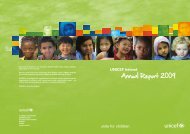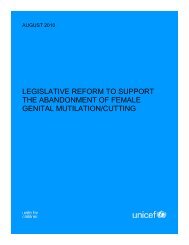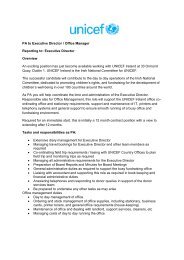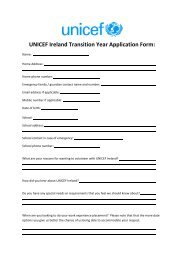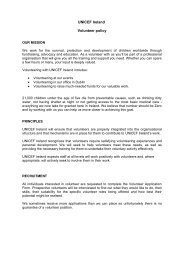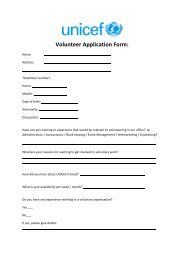Humanitarian Action for Children 2011 - Unicef
Humanitarian Action for Children 2011 - Unicef
Humanitarian Action for Children 2011 - Unicef
- No tags were found...
You also want an ePaper? Increase the reach of your titles
YUMPU automatically turns print PDFs into web optimized ePapers that Google loves.
degradation and the erosion of territories andlivelihoods. Large-scale humanitarian impactsare expected as water and food securitydeteriorate, floods and storms lay waste tocities and essential infrastructure, and peopleare displaced. <strong>Children</strong>, as ever, will be in theeye of the storm. 2The result of these trends is an increase inthe number of people requiring humanitarianassistance and of populations at risk, andthis increase requires a strengthened and moreagile response capacity. It also means that theinternational aid system must be retooled tobetter manage unpredictability and addressunderlying vulnerabilities. While this is a vitalgoal of development work, humanitarianaction holds an important place in lesseninghardships and preparing the ground <strong>for</strong> morerobust recovery and risk management in thefuture. In this overall context of growing complexityand need, UNICEF, which responds tomore than 200 emergencies each year, is committedto supporting governments and helpingpeople build their own resilience, through thehumanitarian action outlined in this report, aswell as in its regular pro gramming.Understanding resilienceRooted in materials science and ecology, theconcept of resilience has increasingly gainedtraction in the work of various social disciplines.While nuances vary, resilience generallydescribes the ability to anticipate, withstandand bounce back from external pressures andResilience generally describes theability to anticipate, withstand andbounce back from external pressuresand shocks in ways that avoid afundamental loss of identity andmaintain core functions.shocks – whether physical, emotional, economic,or related to disaster or conflict – inways that avoid a fundamental loss of identityand maintain core functions. 3 Some interpretationshighlight adeptness at changing direction,rather than resisting change, as a definingcharacteristic of resili ence; 4 here adversity canbecome a catalyst <strong>for</strong> trans<strong>for</strong>mation. For thehumanitarian com mun ity, the common understandingof resili ence that follows can offer auseful lens to examine and address increasinglycomplex crisis contexts.In its simplest <strong>for</strong>m, resilience can be bestconceptualized as the ability of critical physicalinfrastructure to absorb shocks. 5 For instance,the development of appropriate sanitationtechnologies <strong>for</strong> flood-prone areas can reducethe risk of infectious disease in the wake ofa weather disaster. 6 But the concept is muchbroader than simply structural <strong>for</strong>tification andhardware. It provides a lens <strong>for</strong> under standinghow effectively social systems and their variouscomponents – individuals, families, schools,cities, states, and the family of states thatconstitutes the international system – guardagainst risk and collectively manage threats.Developmental psychologists, <strong>for</strong> example,try to use resilience as a way to capture thetraits, skills and circumstances that leadsome children to do well despite experiencingextreme deprivation or violence. Amongdevelopmental thinkers, resilience is appliedto communities, which are seen to possessmultiple sources of strength and resources 7 –including human, material and social capital. 8These sources may be rooted in traditions ordeveloped over time and tapped during crisesto reduce and manage loss. At yet a higherlevel of social organization, resilience has alsobeen used as a characteristic of states, as inthe analysis of state-building in fragile andconflict-affected situations carried out by theOrganisation <strong>for</strong> Economic Co-operation andDevelopment’s Fragile States Group. 9 Here,resilience is contrasted with fragility, whichis rooted in social contracts that are weakor exclusionary and implies failures in corefunctions of the state, including failure toprovide security and basic services.Resilience is there<strong>for</strong>e a property of differentinterconnected levels of social and politicalorganization. Highly resilient systems haveboth risk exposure and response capacitiesbroadly distributed among groups. 10 Inequitiesand the uneven distribution of skills andresources can undermine resilience. 11 If adisaster or crisis outstrips coping capacities,2 <strong>2011</strong> UNICEF <strong>Humanitarian</strong> <strong>Action</strong> FOR CHILDREN | www.unicef.org/hac<strong>2011</strong>




